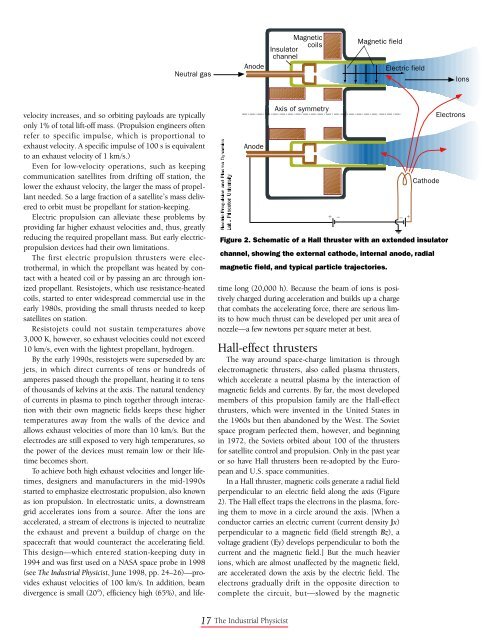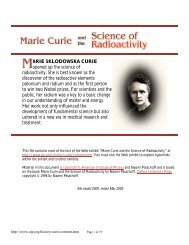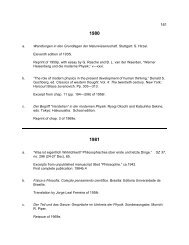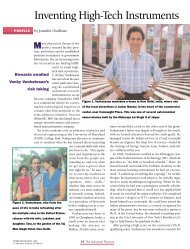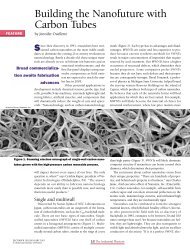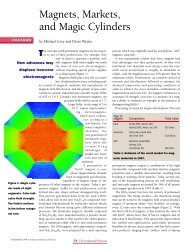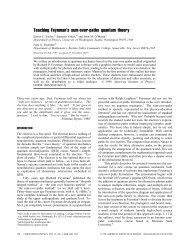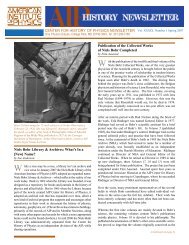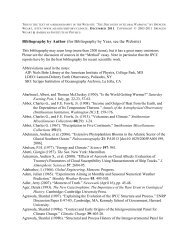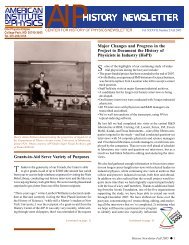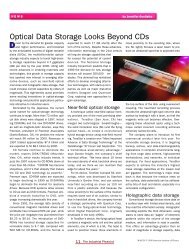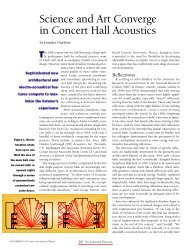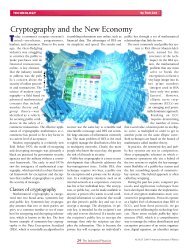Plasma Propulsion in Space - American Institute of Physics
Plasma Propulsion in Space - American Institute of Physics
Plasma Propulsion in Space - American Institute of Physics
You also want an ePaper? Increase the reach of your titles
YUMPU automatically turns print PDFs into web optimized ePapers that Google loves.
Neutral gas<br />
velocity <strong>in</strong>creases, and so orbit<strong>in</strong>g payloads are typically<br />
only 1% <strong>of</strong> total lift-<strong>of</strong>f mass. (<strong>Propulsion</strong> eng<strong>in</strong>eers <strong>of</strong>ten<br />
refer to specific impulse, which is proportional to<br />
exhaust velocity. A specific impulse <strong>of</strong> 100 s is equivalent<br />
to an exhaust velocity <strong>of</strong> 1 km/s.)<br />
Even for low-velocity operations, such as ke e p i n g<br />
communication satellites from drift<strong>in</strong>g <strong>of</strong>f station, the<br />
lower the exhaust velocity, the larger the mass <strong>of</strong> propellant<br />
needed. So a large fraction <strong>of</strong> a satellite’s mass delivered<br />
to orbit must be propellant for station-keep<strong>in</strong>g.<br />
Electric propulsion can alleviate these problems by<br />
provid<strong>in</strong>g far higher exhaust velocities and, thus, greatly<br />
reduc<strong>in</strong>g the required propellant mass. But early electricpropulsion<br />
devices had their own limitations.<br />
The first electric propulsion thrusters were electrothermal,<br />
<strong>in</strong> which the propellant was heated by contact<br />
with a heated coil or by pass<strong>in</strong>g an arc through ionized<br />
propellant. Resistojets, which use resistance-heated<br />
coils, started to enter widespread commercial use <strong>in</strong> the<br />
early 1980s, provid<strong>in</strong>g the small thrusts needed to keep<br />
satellites on station.<br />
Resistojets could not susta<strong>in</strong> temperatures above<br />
3,000 K, however, so exhaust velocities could not exceed<br />
10 km/s, even with the lightest propellant, hydrogen.<br />
By the early 1990s, resistojets were superseded by arc<br />
jets, <strong>in</strong> which direct currents <strong>of</strong> tens or hundreds <strong>of</strong><br />
amperes passed though the propellant, heat<strong>in</strong>g it to tens<br />
<strong>of</strong> thousands <strong>of</strong> kelv<strong>in</strong>s at the axis. The natural tendency<br />
<strong>of</strong> currents <strong>in</strong> plasma to p<strong>in</strong>ch together through <strong>in</strong>teraction<br />
with their own magnetic fields keeps these higher<br />
temperatures away from the walls <strong>of</strong> the device and<br />
allows exhaust velocities <strong>of</strong> more than 10 km/s. But the<br />
electrodes are still exposed to very high temperatures, so<br />
the power <strong>of</strong> the devices must rema<strong>in</strong> low or their lifetime<br />
becomes short.<br />
To achieve both high exhaust velocities and longer lifetimes,<br />
designers and manufacturers <strong>in</strong> the mid-1990s<br />
started to emphasize electrostatic propulsion, also known<br />
as ion propulsion. In electrostatic units, a downstream<br />
grid accelerates ions from a source. After the ions are<br />
accelerated, a stream <strong>of</strong> electrons is <strong>in</strong>jected to neutralize<br />
the exhaust and prevent a buildup <strong>of</strong> charge on the<br />
spacecraft that would counteract the accelerat<strong>in</strong>g field.<br />
This design—which entered station-keep<strong>in</strong>g duty <strong>in</strong><br />
1994 and was first used on a NASA space probe <strong>in</strong> 1998<br />
(see The Industrial Physicist, June 1998, pp. 24–26)—provides<br />
exhaust velocities <strong>of</strong> 100 km/s. In addition, beam<br />
divergence is small (20°), efficiency high (65%), and life-<br />
Anode<br />
Anode<br />
Figure 2. Schematic <strong>of</strong> a Hall thruster with an extended <strong>in</strong>sulator<br />
channel, show<strong>in</strong>g the external cathode, <strong>in</strong>ternal anode, radial<br />
magnetic field, and typical particle trajectories.<br />
time long (20,000 h). Because the beam <strong>of</strong> ions is positively<br />
charged dur<strong>in</strong>g acceleration and builds up a charge<br />
that combats the accelerat<strong>in</strong>g force, there are serious limits<br />
to how much thrust can be developed per unit area <strong>of</strong><br />
nozzle—a few newtons per square meter at best.<br />
Hall-effect thrusters<br />
The way around space-charge limitation is through<br />
electromagnetic thrusters, also called plasma thrusters,<br />
which accelerate a neutral plasma by the <strong>in</strong>teraction <strong>of</strong><br />
magnetic fields and currents. By far, the most developed<br />
members <strong>of</strong> this propulsion family are the Hall-effect<br />
thrusters, which were <strong>in</strong>vented <strong>in</strong> the United States <strong>in</strong><br />
the 1960s but then abandoned by the West. The Soviet<br />
space program perfected them, however, and beg<strong>in</strong>n<strong>in</strong>g<br />
<strong>in</strong> 1972, the Soviets orbited about 100 <strong>of</strong> the thrusters<br />
for satellite control and propulsion. Only <strong>in</strong> the past year<br />
or so have Hall thrusters been re-adopted by the European<br />
and U.S. space communities.<br />
In a Hall thruster, magnetic coils generate a radial field<br />
perpendicular to an electric field along the axis (Figure<br />
2). The Hall effect traps the electrons <strong>in</strong> the plasma, forc<strong>in</strong>g<br />
them to move <strong>in</strong> a circle around the axis. [When a<br />
conductor carries an electric current (current density Jx)<br />
perpendicular to a magnetic field (field strength Bz), a<br />
voltage gradient (Ey) develops perpendicular to both the<br />
current and the magnetic field.] But the much heavier<br />
ions, which are almost unaffected by the magnetic field,<br />
are accelerated down the axis by the electric field. The<br />
electrons gradually drift <strong>in</strong> the opposite direction to<br />
complete the circuit, but—slowed by the magnetic<br />
17 The Industrial Physicist<br />
Magnetic<br />
coils<br />
Insulator<br />
channel<br />
Axis <strong>of</strong> symmetry<br />
Magnetic field<br />
Electric field<br />
+ _ _ +<br />
Cathode<br />
Ions<br />
Electrons


